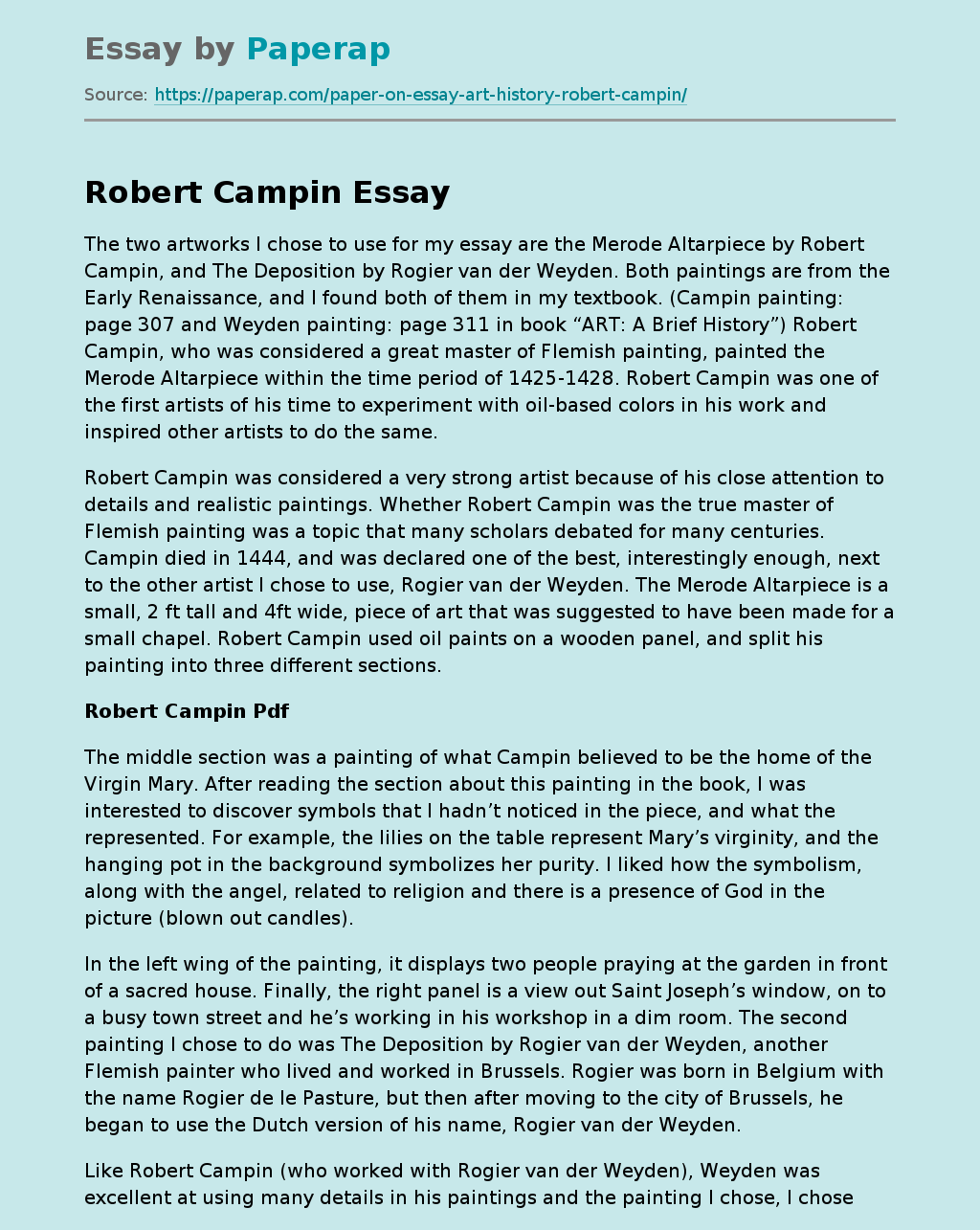Comparing Merode Altarpiece and The Deposition
The two artworks I chose to use for my essay are the Merode Altarpiece by Robert Campin, and The Deposition by Rogier van der Weyden.
Both paintings are from the Early Renaissance, and I found both of them in my textbook. (Campin painting: page 307 and Weyden painting: page 311 in book “ART: A Brief History”) Robert Campin, who was considered a great master of Flemish painting, painted the Merode Altarpiece within the time period of 1425-1428. Robert Campin was one of the first artists of his time to experiment with oil-based colors in his work and inspired other artists to do the same.
Robert Campin was considered a very strong artist because of his close attention to details and realistic paintings. Whether Robert Campin was the true master of Flemish painting was a topic that many scholars debated for many centuries. Campin died in 1444, and was declared one of the best, interestingly enough, next to the other artist I chose to use, Rogier van der Weyden. The Merode Altarpiece is a small, 2 ft tall and 4ft wide, piece of art that was suggested to have been made for a small chapel. Robert Campin used oil paints on a wooden panel, and split his painting into three different sections.
Robert Campin Pdf
The middle section was a painting of what Campin believed to be the home of the Virgin Mary. After reading the section about this painting in the book, I was interested to discover symbols that I hadn’t noticed in the piece, and what the represented.
For example, the lilies on the table represent Mary’s virginity, and the hanging pot in the background symbolizes her purity. I liked how the symbolism, along with the angel, related to religion and there is a presence of God in the picture (blown out candles).
In the left wing of the painting, it displays two people praying at the garden in front of a sacred house. Finally, the right panel is a view out Saint Joseph’s window, on to a busy town street and he’s working in his workshop in a dim room. The second painting I chose to do was The Deposition by Rogier van der Weyden, another Flemish painter who lived and worked in Brussels. Rogier was born in Belgium with the name Rogier de le Pasture, but then after moving to the city of Brussels, he began to use the Dutch version of his name, Rogier van der Weyden.
Like Robert Campin (who worked with Rogier van der Weyden), Weyden was excellent at using many details in his paintings and the painting I chose, I chose for the outstanding detail. The Deposition was created around 1442, much later then Campin’s painting. The painting again, is oil on a wood panel (perhaps Robert Campin’s work was influential? ) and it’s 7’2 5/8 X 8’ 7 1/8 in size. The scene here is very dramatic and captivating, in a majorly depressing way. In the painting, Jesus is being carried away from the cross where he passed away by those who loved him.
The fine detail on everyone’s faces completely expresses so much emotion. These people were horrified with what happened and their mourning and grieving is shown powerfully in this picture. Jesus’ body position in the scene is very similar to that of the Virgin Mary, who has fainted on the floor. Both the center of each body and the placement of their arms are incredibly comparable. Jesus’ body looks to me, much whiter and brighter then anyone else’s, and I liked that Weyden used brighter colors to make Jesus stand out and elevate his importance in the picture.
Although Jesus and Mary are the two most noticeable figures in this piece, I was also very intrigued by the other people in the background. Every face is detailed so well, and the emotional essence from each face is extremely powerful and well done. What I discovered about these paintings is that there are many similarities. Starting with the artists, I found it very interesting that one actually taught the other and Robert Campin was probably was a very big influence on Rogier van der Weyden. Both these Flemish painters used oil paints on a wood panel, both had incredible detail, and both pieces were very religious.
What I liked about these pictures was the detail and religious references. The detail in both these pieces are amazing, both painters used many details to help get emotions out of whoever observed their work. In Campin’s piece, the angels face and Mary’s faces particularly stood out to me. Both figures had such calm, serene faces and the feeling I got was very peaceful. On the other hand, in Weyden’s painting, the anguish and sorrow shown by the detail on each person’s face gave me a sad, depressing feeling. The different emotions I saw and felt from the detail in the faces is what drew me to these pictures.
Even the backgrounds of these pictures, and the details on the clothing, were incredible and since I like photography that’s done with very high definition cameras, I’m interested in fine particulars and these paintings were very well detailed. Other then the details, I enjoyed the religious content in each picture. All the religious symbolism was interesting, and I liked seeing how each artist painted the Virgin Mary differently. Both of these paintings were appealing to me because of how they were painted, and what they represented, and I enjoyed learning about each artist and picture.
Comparing Merode Altarpiece and The Deposition. (2019, Dec 05). Retrieved from https://paperap.com/paper-on-essay-art-history-robert-campin/

